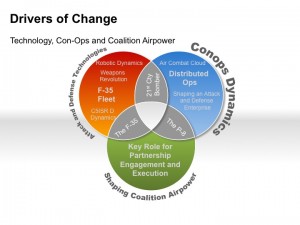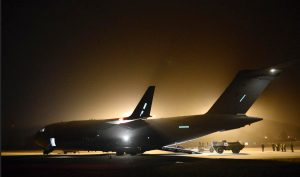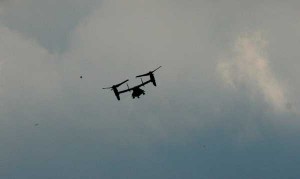2013-11-10 by Robbin Laird
Frequently peppering American presentations about the evolution of military strategies, approaches and capabilities are references to the central importance of coalitions and of partners.
But what is not often realized is HOW fundamentally the situation has changed over the past thirty years.
When coalitions and partners were used in the late 20th century it really referred to allies in alliances which provided basing or capabilities which could SUPPLEMENT or COMPLIMENT American naval and air power.
But all of this has changed with this decade of the 21st century and the decade ahead.
It is now about coalitions and partners as the ENABLERS for American naval and airpower, not merely by supplementing or complementing but providing core elements for engagement and execution of military operations.
The significant drop off in the numbers of air and naval platforms certainly have created the situation within which the American ability to provide for global reach is significantly curtailed.
This means that global reach is a function of the ability to not just work with allies but to shape convergent concepts of operations and convergent or complimentary capabilities.
And this will occur in a world where US defense industry’s ability to provide the equipment for the US-allied operational world will go down, as European and Asian providers expand their reach as well.
http://thediplomat.com/2013/08/16/america-pivots-to-asia-europe-arms-it/
There is another aspect to the partnership and coalition transformation as well.
The United States is rolling out key elements of its 21st century military technologies at the same time as they enter into service with core allies.

The roll out of the F-35 fleet as a front line fighter for the USMC, the USAF and the USN (in that order) is occurring simultaneously with the roll out of the F-35 fleet by European, Middle Eastern and Asian partners.
This is an unprecedented roll out of convergent capabilities and rethink of coalition concepts of operations.
Associated with the roll out of the F-35 fleet is a global production system ranging from Europe to the US to Asia and the shaping of a global sustainment system which provides parts and combat support worldwide.
This will require a significant cultural shift in the thinking of the US services and of allies in understanding what globality will mean to their individual or coalition operations.
As Lt. General Preziosa, the Italian Chief of Staff of the Air Force has underscored:
“Australia, Japan, Italy, the UK, the U.S. and others will share their production and sustainment capabilities for the F-35 and learn how to apply lessons learned from the use of a coalition aircraft in dealing with the evolving 21st century problems. This is not yesterday’s aircraft being applied to the challenges of the next 30 years; it is about reshaping concepts of operations for coalitions meeting the evolving new challenges and operational requirements.”
He emphasized that the presence of Australia in Afghanistan demonstrated that a country far from a geographical area moved force into deal with a threat identified by a coalition with which it worked. And airpower has been central to Afghan operations.
“We use airpower for virtually everything to support the guys on the ground. They rely heavily upon airpower to deliver the ordinance to protect them and to engage the enemy.”

He argued further that: “We will discover the new dimension of airpower using this type of aircraft.”
The coalition quality of the aircraft is built in was a key theme of his discussion.
“Interoperability is built into the aircraft; we use the same combat systems; we fuse data the same way; we have the same symbiology in the cockpit. It will be up to the new generation of pilots and squadron leaders to figure how to maximize these inherent advantages.”
Another example of the concurrent roll out of new systems by the US and a key ally is the case of the P-8 with the Indian and American navies.
The concurrent introduction of the P-8 into the Indian and American navies provides an opportunity to share experiences with how to shape 21st century approaches to maritime security, whether done separately or together. In effect, the P-8 will be part of the evolving naval collaborative framework between the Indians and the U.S. as well as with other allies.
What makes the P-8 an especially interesting platform is that it is a shared platform between India and the U.S. with others (such as Australia) likely to join in and this sharing of a platform can provide a tool for enhancing collaboration in the daunting task of shaping effective ISR for 21st century maritime missions.

The opportunity is inherent in the technology; the challenge will be to shape the collaborative approach and shared concepts of operations.
https://sldinfo.com/indian-and-american-naval-cooperation-the-potential-role-of-the-p-8/
In effect, the partnership aspect is inherent in re-crafting fundamental American strategies.
With regard to the Pacific, we have argued in our new book that the allies are always forward deployed.
https://sldinfo.com/rebuilding-american-military-power-in-the-pacific-a-21st-century-strategy/
We need to shape a scalable force, which is capable of reachback to bring assets as needed to missions as appropriate.
This means shaping an effective working set of relationships with allies so that they have capabilities with which we can plug and play and that they, in turn, have confidence that we can bring RELEVANT capabilities to the fight, rather than just piling on with legacy equipment and concepts of operations.
It is not about a linear system of projecting power FORWARD; it is about an ability to distribute forces that can be aggregated effectively with those of allies or to converge on required national missions as well.
We have already seen in the Libyan and Mali missions, the glimmers of the future. In Libya, allies shaped a baseline of objectives and used air and naval power to bring down the regime. The US term for this was to “lead from behind” but what it really was a transition from the US determining the objectives and leading the operation to one where the US engage in the operation with its assets to shape a coalition outcome.
In the Mali case, the French led the operation; and the US supported. Full stop. This was not about the US support being indispensable to the definition of the mission; it was about the US providing missing assets to facilitate a French run operation.
http://breakingdefense.com/2011/10/marine-libya-lessons-short-command-control-links-stovl-flexibi/
http://breakingdefense.com/2011/09/french-libya-lessons-learned-better-targeting-flexible-roes-l/
http://breakingdefense.com/2013/06/french-lessons-from-mali-fight-alone-supply-together/
Neither of these operations was perfect, nor a complete set of case books for the future.
But what they do show is that learning how to shape support or to lead with allied approaches to support is crucial to re-shape American military engagement policies for the period ahead.
These are not simply 20th century partnerships; they are building blocks for real coalition capabilities and operations.
And systems like the F-35 and the P-8 are part of this future, and not simply repetitions from the past.
For a look at one key example of the shift, see the role of the Italians in the F-35 program and the approach, which they are taking toward coalition airpower:
https://sldinfo.com/flipbooks/Italy/ItalianF-35SpecialReport1/
https://sldinfo.com/cameri-italy-and-the-f-35-special-report/

